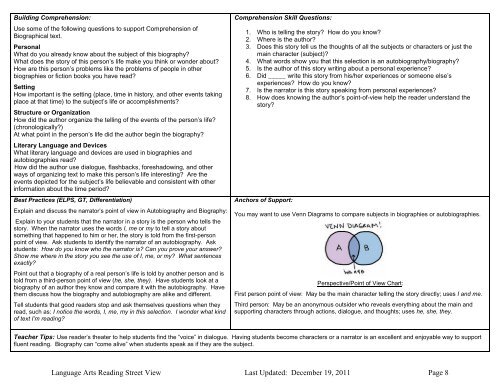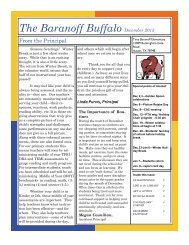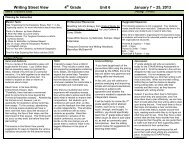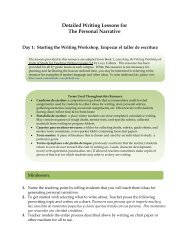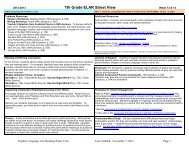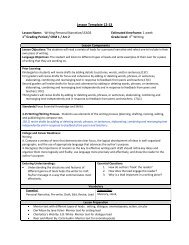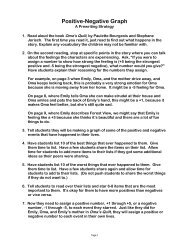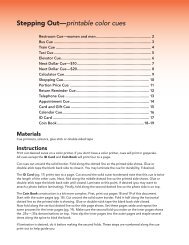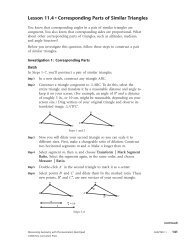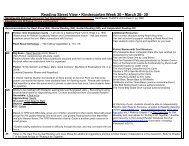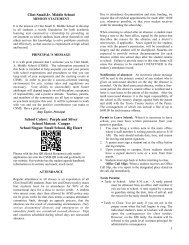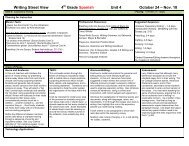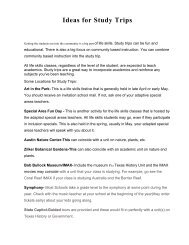Reading street view • 5th grade • week 19 • jan. 5-6
Reading street view • 5th grade • week 19 • jan. 5-6
Reading street view • 5th grade • week 19 • jan. 5-6
You also want an ePaper? Increase the reach of your titles
YUMPU automatically turns print PDFs into web optimized ePapers that Google loves.
Building Comprehension:Use some of the following questions to support Comprehension ofBiographical text.PersonalWhat do you already know about the subject of this biography?What does the story of this person’s life make you think or wonder about?How are this person’s problems like the problems of people in otherbiographies or fiction books you have read?SettingHow important is the setting (place, time in history, and other events takingplace at that time) to the subject’s life or accomplishments?Structure or OrganizationHow did the author organize the telling of the events of the person’s life?(chronologically?)At what point in the person’s life did the author begin the biography?Literary Language and DevicesWhat literary language and devices are used in biographies andautobiographies read?How did the author use dialogue, flashbacks, foreshadowing, and otherways of organizing text to make this person’s life interesting? Are theevents depicted for the subject’s life believable and consistent with otherinformation about the time period?Best Practices (ELPS, GT, Differentiation)Explain and discuss the narrator’s point of <strong>view</strong> in Autobiography and Biography:Explain to your students that the narrator in a story is the person who tells thestory. When the narrator uses the words I, me or my to tell a story aboutsomething that happened to him or her, the story is told from the first-personpoint of <strong>view</strong>. Ask students to identify the narrator of an autobiography. Askstudents: How do you know who the narrator is? Can you prove your answer?Show me where in the story you see the use of I, me, or my? What sentencesexactly?Point out that a biography of a real person’s life is told by another person and istold from a third-person point of <strong>view</strong> (he, she, they). Have students look at abiography of an author they know and compare it with the autobiography. Havethem discuss how the biography and autobiography are alike and different.Tell students that good readers stop and ask themselves questions when theyread, such as: I notice the words, I, me, my in this selection. I wonder what kindof text I’m reading?Comprehension Skill Questions:1. Who is telling the story? How do you know?2. Where is the author?3. Does this story tell us the thoughts of all the subjects or characters or just themain character (subject)?4. What words show you that this selection is an autobiography/biography?5. Is the author of this story writing about a personal experience?6. Did _____ write this story from his/her experiences or someone else’sexperiences? How do you know?7. Is the narrator is this story speaking from personal experiences?8. How does knowing the author’s point-of-<strong>view</strong> help the reader understand thestory?Anchors of Support:You may want to use Venn Diagrams to compare subjects in biographies or autobiographies.Perspective/Point of View Chart:First person point of <strong>view</strong>: May be the main character telling the story directly; uses I and me.Third person: May be an anonymous outsider who reveals everything about the main andsupporting characters through actions, dialogue, and thoughts; uses he, she, they.Teacher Tips: Use reader’s theater to help students find the “voice” in dialogue. Having students become characters or a narrator is an excellent and enjoyable way to supportfluent reading. Biography can “come alive” when students speak as if they are the subject.Language Arts <strong>Reading</strong> Street View Last Updated: December <strong>19</strong>, 2011 Page 8


